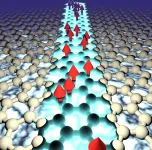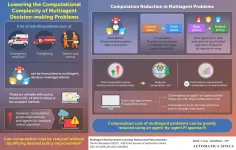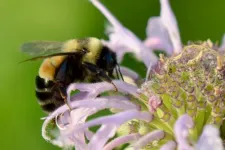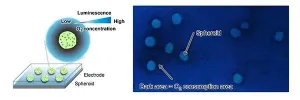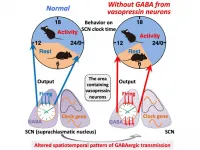A pioneering study: Plant roots act like a drill
Plant roots screw themselves into the ground - just like a drill penetrating a wall
2021-04-28
(Press-News.org) In an interdisciplinary research project carried out at Tel Aviv University, researchers from the School of Plant Sciences affiliated with the George S. Wise Faculty of Life Sciences collaborated with their colleagues from the Sackler Faculty of Medicine in order to study the course of plant root growth. The plant researchers were aided by a computational model constructed by cancer researchers studying cancer cells, which they adapted for use with plant root cells.
The fascinating and groundbreaking findings: For the first time in the world, it has been demonstrated, at the resolution of a single cell, that the root grows with a screwing motion - just like a drill penetrating a wall. In the wake of this study, the cancer researchers conjecture that cancer cells, too, are assisted by a spiral motion in order to penetrate healthy tissue in the environment of the tumor, or to create metastases in various organs of the body.
The research was led by Prof. Eilon Shani from the School of Plant Sciences and Food Security and Prof. Ilan Tsarfaty from the Department of Clinical Microbiology and Immunology at Tel Aviv University, and was conducted in collaboration with researchers from the USA, Austria and China. The article was published in March 2021 in the acclaimed journal Nature Communications.
The researchers in Prof. Shani's group, led by Dr. Yangjie Hu, used as a model the plant known as Arabidopsis. They marked the nuclei of the root cells with a fluorescent protein and observed the growing process and movement of the cells at the root tip through a powerful microscope - approximately 1000 cells in each movie. Furthermore, in order to examine what causes and controls the movement, they focused on a known hormone named auxin, which regulates growth in plants. They built a genetic system that enables activation of auxin production (like a switch) in a number of selected cells-types, and then monitored the influence of the on/off mechanism, in four dimensions - the three spatial dimensions and the dimension of time. After each instance of auxin biosynthesis, each of the thousand cells was video recorded for a period of 6 to 24 hours, thus an enormous amount of data accumulated.
For the next stage, the researchers were aided by the computational tools provided by Prof. Tsarfaty, which had been developed in his laboratory for the purpose of monitoring the development of cancerous growths. They used these tools to analyze the imaging data obtained in the study. Thus they were actually able, for the first time, to observe with their own eyes the corkscrew movement of the root, as well as to precisely quantify and chart some 30 root growth parameters relating to time and space - including acceleration, length, changes in cell structure, coordination between cells during the growth process and velocity - for each one of the thousand cells at the root tip. Using fluorescent reporters, the findings even allowed them to precisely assess the movement and the influence of the auxin on the root, and the way in which it controls the growth process.
Prof. Shani: "Plants present special challenges to researchers. For example, half of the plant (the hidden half), namely, the root system, is buried beneath the ground. The computational tools that were developed for cancer research have enabled us, for the first time, to precisely measure and quantify the kinetics of growth and to reveal the mechanisms that control it at the resolution of a single cell. By this they have significantly advanced plant research, an area of utmost importance for society - both from an environmental point of view and in terms of agriculture and feeding the population."
Prof. Shani adds: "In the course of our study we discovered a fascinating phenomenon that had not been previously observed 'live': we saw that the cells at the root tip move in a spiral motion, like a drill penetrating the earth. We also recognized that the hormone auxin controls the screwing process of the root tip. We learned and measured the directions of the auxin hormone's movement, passing from one cell to another in the root, in order to control the growth of the root and the corkscrew motion."
Prof. Tsarfaty adds: "This was a synergetic collaboration that benefited and enlightened both parties. In plants, processes take place much more rapidly, and therefore constitute an excellent model for us. In consequence of the findings provided by this plant study, we are presently examining the possibility of a similar screw-like motion in cancer cells and in metastases, in the course of their penetration into adjacent healthy tissues."
INFORMATION:
ELSE PRESS RELEASES FROM THIS DATE:
2021-04-28
In the quantum realm, electrons can group together to behave in interesting ways. Magnetism is one of these behaviors that we see in our day-to-day life, as is the rarer phenomena of superconductivity. Intriguingly, these two behaviors are often antagonists, meaning that the existence of one of them often destroys the other. However, if these two opposite quantum states are forced to coexist artificially, an elusive state called a topological superconductor appears, which is exciting for researchers trying to make topological qubits.
Topological qubits are exciting as one of the potential technologies for future quantum computers. In particular, topological qubits provide the basis for topological quantum ...
2021-04-28
Even though more and more vaccines against the coronavirus are being administered all over the world, many countries are still battling with outbreaks and face difficulties providing help to those in need.
One of those countries is Brazil. Here, they are facing a massive second wave outbreak, many daily deaths and instances of the health care systems collapsing. In the city of Manaus things have looked exceptionally bleak from December and through to the early spring.
The city was hit so hard by the first wave in 2020 that it was actually thought to be one of the few places in the world to have reached herd immunity. An estimated 75 percent of the population in the city had been infected. But then the second wave ...
2021-04-28
The research team led by Prof. WENG Jianping from University of Science and Technology of China (USTC) of the Chinese Academy of Sciences has implemented a comprehensive preconception-to-pregnancy management plan, namely CARNATION study, for women with type1 diabetes (T1D), to reduce the risks of adverse pregnancy outcomes and improve the pregnancy care since 2015. The study was published in Diabetes Care.
The management plan, approved by the National Health and Family Planning Commission of the People's Republic of China, is made up of the checklist for the relevant health care providers (HCPs) covering 20 items of care in different ...
2021-04-28
Computer scientists often encounter problems relevant to real-life scenarios. For instance, "multiagent problems," a category characterized by multi-stage decision-making by multiple decision makers or "agents," has relevant applications in search-and-rescue missions, firefighting, and emergency response.
Multiagent problems are often solved using a machine learning technique known as "reinforcement learning" (RL), which concerns itself with how intelligent agents make decisions in an environment unfamiliar to them. An approach usually adopted in such an endeavor is policy iteration (PI), which starts off with a "base policy" and then improves on it to generate a "rollout policy" (with the process of generation ...
2021-04-28
CHAMPAIGN, Ill. -- For more than a decade, ecologists have been warning of a downward trend in bumble bee populations across North America, with habitat destruction a primary culprit in those losses. While efforts to preserve wild bees in the Midwest often focus on restoring native flowers to prairies, a new Illinois-based study finds evidence of a steady decline in the availability of springtime flowers in wooded landscapes.
The scarcity of early season flowers in forests - a primary food source for bumble bees at this time of year - likely endangers ...
2021-04-28
WASHINGTON - The Society for Cardiovascular Angiography and Interventions (SCAI) has released an expert consensus statement providing cardiologists, cath lab directors, and hospital leadership guidance for contemporary cath lab standards. The document, "SCAI Expert Consensus Update on Best Practices in the Cardiac Catheterization Laboratory" will be presented today at the SCAI 2021 Virtual Scientific Sessions with simultaneous publication in Catheterization & Cardiovascular Interventions. The statement has been endorsed by the American College of Cardiology Clinical Policy Approval Committee, American Heart Association, ...
2021-04-28
Cells breathe, to an extent, exchanging gases, taking in energy sources from the environment and processing it. Now, researchers from Tohoku University in Japan have shone a light on the process in a new way.
Their demonstrated visualization method in model systems was made available online on March 12th in Biosensors and Bioelectronics, ahead of the June print edition.
The researchers used spheroids - cultured cells within a close-to-natural environment - to mimic a biological tissue using mesenchymal stem cells (MSCs). Due to MCSs' ability to self-renew and differentiate into various ...
2021-04-28
Our bodies and behaviors often seem to have rhythms of their own. Why do we go to the bathroom at the same time every day? Why do we feel off if we can't go to sleep at the right time? Circadian rhythms are a behind-the-scenes force that shape many of our behaviors and our health. Michihiro Mieda and his team at Kanazawa University in Japan are researching how the brain's circadian rhythm control center regulates behavior.
Termed the superchiasmatic nucleus, or SCN, the control center contains many types of neurons that transmit signals using the molecule GABA, but little is known about how each type contributes to our bodily rhythms. In their newest study, the researchers focused on GABA neurons that produce arginine vasopressin, a hormone that regulates ...
2021-04-28
WASHINGTON, D.C, (April 28, 2021) - A new study reveals the use of a potassium ferrate hemostatic patch (PFHP) reduces the time to hemostasis for patients receiving cardiac catherization. The findings indicate a faster approach to removing the compression band used during the procedure, without compromising safety. Positive results of the STAT2 trial follow an initial pilot study and are being presented as late-breaking clinical science at the Society for Cardiovascular Angiography and Interventions (SCAI) 2021 Virtual Scientific Sessions.
Cardiac ...
2021-04-28
WASHINGTON, D.C, (April 28, 2021) - A retrospective analysis of risk factors for coronary artery disease (CAD) in young African American patients is being presented today at the Society for Cardiovascular Angiography and Interventions (SCAI) 2021 Virtual Scientific Sessions. The findings reveal this specific patient segment, African-Americans under age 45, experiences greater CAD risk factors related to smoking, drug and alcohol abuse, HIV as well as mental health conditions including anxiety and depression.
CAD is the most common type of heart disease, with high blood pressure, obstructive sleep apnea and diabetes among traditional risk factors. African Americans are disproportionally ...
LAST 30 PRESS RELEASES:
[Press-News.org] A pioneering study: Plant roots act like a drill
Plant roots screw themselves into the ground - just like a drill penetrating a wall
